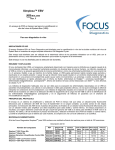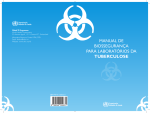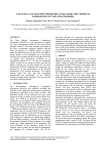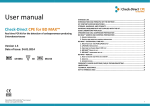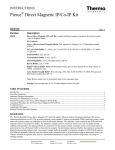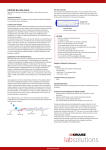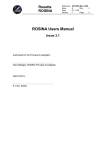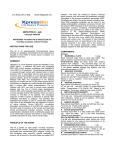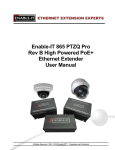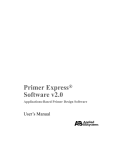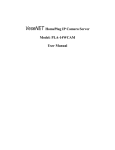Download 3B BIOTUB QT Kit QT Kit - 3B BlackBio Biotech India Limited
Transcript
3B BIOTUB® QT Kit MTB/ NTM Real Time PCR Detection 0|Page 3B BIOTUB QT Kit www.3bblackbio.com 3B BIOTUB® QT Kit MTB/ NTM Real Time PCR Detection For detection and differentiation of Mycobacterium tuberculosis complex (MTBC) and nontuberculous mycobacteria (NTM) from human specimens For use with ABI Prism 7500 SDS, 7500 Fast SDS, ViiA™ 7 and QuantStudio™ 12K Flex (Applied Biosystems) Rotor otor-Gene Q5/6 plex Platform (Qiagen) CFX384 Touch™, CFX96 Touch™ (BioRad) PicoReal 24, PicoReal 96 (Thermo) LightCycler® 96 (Roche) LineGene K, LineGene 9600 (Bioer) FOR IN VITRO DIAGNOSTIC USE Product No.: 111111 48 tests Temperature limitation April 2013 3B BlackBio Biotech India Ltd. 1|Page 3B BIOTUB QT Kit www.3bblackbio.com CONTENT PAGE NO. INTENDED USE 3 PRINCIPLE 3 REAGENTS 4 3B MTB/NTM REAL TIME KIT 4 MTB DNA EXTRACTION KIT 5 INSTRUCTIONS FOR USE 6 Sample collection 6 Sputum samples 6 Tissues 6 Urine 6 Aseptic fluids (body fluid, bone marrow, blood), Bronchial washing 6 Stool 7 Preparation of Samples 8 Viscous Fluids (sputum, body fluids, Pus) 8 Non-viscous -viscous Fluids (aspiration, body fluids, urine, pleural fluid) 8 Fresh tissue (Biopsy, Endometrium tissue) 9 Paraffin-- embedded tissue 10 Stool 10 Blood, Bone marrow aspiration, Menstrual blood 10 Broncho Alveolar La Lavage (BAL) 11 DNA Extraction Step 12 REAL TIME PCR PROTOCOL FOR MTB/NTM DETECTION 15 RESULT ANALYSIS 16 SPECIFICATIONS 18 TROUBLESHOOTING 21 STORAGE AND HANDLING & ADDITIONAL REQUIREMENTS 23 GENERAL PRECAUTIONS 24 REFERENCES 25 2|Page 3B BIOTUB QT Kit www.3bblackbio.com INTENDED USE 3B MTB/NTM KIT accurately differentiates Mycobacterium tuberculosis (MTB) from nonnon tuberculosis Mycobacterium species (NTM) in a qualitative/quantitative quantitative form from various sources of clinical samples es using Real time PCR. PRINCIPLE 3B MTB/NTM detection is a Real Real-Time Amplification test for the qualitative/quantitative qualitative detection of Mycobacterium tuberculosis complex (MTC) and Non-tuberculosis tuberculosis mycobacteria (NTM) in clinical samples.. Mycobacterium tuber tuberculosis/ Non-tuberculosis tuberculosis DNA is extracted from samples, amplified using Real Time Amplification and detected using fluorescent reporter dye probes specific for M. tuberculosis complex and all mycobacterium genus.. In real-time real PCR, the fluorescent signal is generated from the presence of an oligonucleotide probe specific for target DNA sequence. The probe contains a fluorescent dye molecule on its 5’ end and a quencher molecule on its 3’ end. The probe hybridizes with one of the chains of the amplified fragment. fra During synthesis of a complementary chain, Taq DNA polymerase which possesses 5' - 3' exonuclease activity cleaves the probe. As a result, the fluorescent dye and quencher dye are separated, and the total fluorescence of reaction volume increases in direct proportion to the number of amplicon copies synthesized during PCR. The fluorescent signal is measured in each cycle of reaction, and the threshold cycle value is determined from the obtained curve. The threshold cycle is proportional to the initia initiall number of DNA copies in a sample and its value allows qualitative/quantitative quantitative comparisons of analyzed and control samples. In 3B MTB/NTM detection kit is based on amplification of region upstream of the 65 kDa heat shock protein (65kDa hsp) gene11, 2, 3 by primer and probes specific for M. tuberculosis complex and mycobacterium genus4. In this kit there are three independent reactions running in parallel in each tube: the first detects Mycobacterium tuberculosis complex (M. tuberculosis, M. africanum, M. bovis, M. bovis BCG, M. microti) ((HEX channel), second detects all mycobacterium by genus specific probe (FAM channel) and the third detects internal control (IC) DNA (Tex Red channel) which allows excluding unreliable results. 3|Page 3B BIOTUB QT Kit www.3bblackbio.com REAGENTS The Kit contains amplification mplification reagents for performance of 48/96 amplification n reactions. Thaw and handle reagents on ice. Do not freeze/thaw Kit vials repeatedly. In case of frequent use, we recommend to aliquot the contents of the vials into 10 reactions each. This will also a rule-out kit/ reagent contamination. 3B MTB/NTM REAL TIME KIT Volume in µL Volume in µL 48 reactions 96 reactions 500 µL 500 µL X 2 100 µL 100 µL X 2 100 µL 100 µL X 2 • MTB Positive ositive Control 50 µL 100 µL • NTM Positive ositive Control 50 µL 100 µL • Sterilized water 50 µL 100 µL Reagent Description • Hot-start start DNA polymerase Multiplex Master Mix • Reaction Buffer • dNTPs (dATP, dCTP, dGTP, dTTP) MgCl2 and stabilizers MTB/ NTM Primer probe mix Internal control Primer probe mix • Primer and probe mix for MTB and NTM detection • Primer, probe and DNA mix for IC detection Positive Control MTB Positive Control NTM Negative Control 4|Page 3B BIOTUB QT Kit www.3bblackbio.com MTB DNA EXTRACTION KIT MTB DNA Extraction Kit Reagent 48 Reactions 96 Reactions 240 Reactions Volume Volume Volume Buffer BT1 20 ml 20 ml X 2 100 0 ml Buffer BB1 12 ml 12 ml X 2 60 ml Reagent BB2 3 ml 3 ml X 2 15 ml 7 ml X 2 7 ml X 4 40 ml X 2 Buffer BBW 30 ml 30 ml X 2 75 ml x 2 Buffer BBE 15 ml 15 ml X 2 75 5 ml Proteinase K (Lyophilized) 30 mg 30 mg X 2 75 mg x 2 Proteinase Buffer 1.8 ml 1.8 ml X 2 8 ml MTB DNA Spin Columns 50 100 250 50 2 ml Collection Tubes 100 200 500 00 Label for Buffer BB3 1 1 1 User Manual 1 1 1 Buffer BB5 (Concentrate) 5|Page 3B BIOTUB QT Kit www.3bblackbio.com INSTRUCTIONS FOR USE A. Sample collection Sputum samples • Collection of early morning sputum specimen is optimal. • Rinse the mouth with water and then should cough deeply to expectorate sputum directly into the sterile, leak leak-proof container. • Samples should bee stored at temperatures of 22-8 ⁰C or freezing. • Fresh biopsies of up to 5 m mm m must be used. Any tissue must be collected aseptically Tissues into a sterile container without fixatives or preservatives. To keep moist add sterile saline to the dried specimen specimen. Keep refrigerated until transport. • Biopsy should be stored at -15±8 ⁰C. • Paraffin-embedded embedded tissues can also be used, in cases where the tissue fixation method does not degrade DNA and purification of DNA is performed with methods specific for this kind of sample. Urine • An early morning midstream specimen should be collected. Multiple specimens over several days are optimal to obtain a positive specimen. • Samples should be stored at temperatures of 22-8 ⁰C or freezing. Aseptic fluids (body fluid, bone marrow, blood blood), Bronchial washing • Body fluids (spinal, pleural, pericardial, synovial, asc ascitic, bone marrow), bronchial secretions/washings washings should be aseptically collected in a sterile container using aspiration tion techniques or surgical procedures. 6|Page 3B BIOTUB QT Kit www.3bblackbio.com • For fluids that may clot, sterile potassium oxalate (0.01 ~ 0.02 ml of 10% neutral oxalate per ml fluid) or heparin (0.2 mg per ml) should be added. Stool • Stool should be passed into a clean and dry container. • Carefully lly open the specimen vial and collect a small sample with the help of a sterile spoon in to a new sterile vial vial. • Close the vial tightly and shake to mix well. Quantity Specimen Type Optimal Minimum 5–10 10 mL 1 mL 5 mL 1 mL CSF 5–15 15 mL 1 mL Abscess (wound)aspirates 5–15 15 mL 1 mL Body fluids/ aspirates 5–15 15 mL 1 mL Urine 30–50mL 50mL 10 mL Stool 2-5 g 1 gm Tissue 5 mm Visible 1-10 10 mL 1 mL Respiratory specimens (sputum, BAL, BW, tracheal aspi aspirate, etc) Blood/bone marrow Pus 7|Page 3B BIOTUB QT Kit www.3bblackbio.com B. Preparation of Samples • Prepare 2% N-Acetyl Acetyl Cystein Cystein/ NaOH [Dissolve 2 g of NaOH, 1.45 g of Sodium citrate, 0.5 g N-acetyl acetyl cystein in 100 ml of sterile distilled water]. • Prepare 0.067M phosphate buffer solution by dissolving 2.37 g of Dibasic Sodium Phosphate (Na2HPO4) and 2.27 g Monobasic Potassium otassium Phosphate in 500 ml of sterile distilled water water. Adjust the final pH to 6.8. i) Viscous Fluids (sputum, sputum, body fluids fluids, Pus): • Homogenize the sample by vigorous vortexing for 55-10 min. • In the 15 ml falcon tube, add the 2% NALC NALC-NaOH with the specimen (sputum/body fluids/urine) to an equal volume (1:1) and vortex for 1 min. • Incubate the mixture for 15 min at room temperature with occasional shaking. • Adjust the volume to 15 ml with sterile water or sterile phosphate buffer solution (pH 6.8) and mix well well. • Transfer 1.5 ml sample to a 2 ml EEppendorf tube using a pipette with a tip with aerosol barrier, mark it, and centrifuge at 10,000 g or 15,000 rpm for 10 min. Discard the supernatant, add 1 ml of PBS solution and mix well well. Note: (if the pellet is not visible, remove the supernatant leaving about 100 10 μl of the sample) • Centrifuge at 10,000 g or 15,000 rpm for 10 min, discard the supernatant and rere suspend the pellet as per DNA extraction step. ii) Non‐viscous Fluids (aspiration, aspiration, body fluids, urine urine, pleural fluid): • Homogenize the sample by vigorous vor vortexing for 5-10 min. • Transfer 1.5 ml of the sample to a 2 ml Eppendorf tube using a pipette with a tip with aerosol barrier, mark it, and centrifuge at 10,000 g or 15,000 rpm for 10 min. min • Discard the supernatant and re-suspend suspend the pellet as per DNA extraction extracti step. 8|Page 3B BIOTUB QT Kit www.3bblackbio.com Note: (if the pellet is not visible, remove the supernatant leaving about 100 μl of the sample) iii) Fresh tissue (Biopsy, Endometrium tissue) • If RBCs are present then give PBS wash to remove RBC’s totally. • If tissues are soft then add NALC NALC-NaOH solution and start processing as described below. If tissues are tough, then grind and homogenize it with PBS in sterile mortarmortar pestle and process as described below. • Process sample in original sample container. If sample is in syringe or small container then transfer fer and process the sample in 50 ml Falcon tube (preferred for more surface area) or 15 ml falcon tube. • To specimen add 2% NALC NALC-NaOH NaOH solution in 1:1 ratio. Incubate for 15-20 15 min depending upon sample consistency at room temperature with intermittent vigorous vortexing. • If the sample is very viscous or appears to be tough/thick then incubate it in water bath of temperature 40 40-50⁰C. • Neutralize the digested digested-decontaminated decontaminated specimens by adding Phosphate buffer saline (PBS) up to 15 ml and mix by inverting. Ce Centrifuge ntrifuge 1.5 ml neutralized sample for 15 min at 13000 rpm. • Wash the pellet with 1ml PBS and centrifuged for 15 min at 13000 rpm. • Check the pH of supernatant and discard it. If pH is neutral then wash pellet with 1ml water and if it is still alkali then gi give ve one more (or two till it become neutral) wash with PBS. • After neutralization give 1 more PBS washing. • Now add 1ml sterile water to the pellet, vortex and centrifuge at 13000 rpm for 10 min. and carefully discard the supernatant. Repeat this step once and an proceed as per DNA Extraction step. 9|Page 3B BIOTUB QT Kit www.3bblackbio.com iv) Paraffin‐ embedded tissue • Add 1 ml of n-Octane Octane or Xylene to the tube containing several pieces of paraffin fragment. • Vortex vigorously and incubate at room temperature for about 30 min. Vortex occasionally. Centrifuge ifuge at 13,000 rpm for 3 min. Pipette off supernatant. (If paraffin remains, repeat step 1 and 2) • Add 1 ml of ethanol (96 (96-100%) and then vortex it. • Centrifuge for 3 min at 13,000 rpm. Pipette o out supernatant. • Repeat step 3 and 4.. Pipette off as much of th the ethanol as possible. • Incubate the open tube at 37 ⁰C C until the ethanol has evaporated (15 min). • Discard the supernatant and re re-suspend suspend the pellet as per DNA extraction step. Note: (if the pellet is not visible, remove the supernatant leaving about 100 μl of the sample) v) Stool • Homogenize the sample by vigorous vortexing for 55-10 min. • Mix the stool (at least 1 g) with 10 ml of 2% NALC-NaOH,, vortex vigorously for 30 sec and incubate ncubate for 15 min at room temperature. • Centrifuge for 10 min at 1,500 rpm, trans transfer fer 1.5 ml of the supernatant to 2 ml Eppendorf tube using a pipette with a tip with aerosol barrier, mark it, and centrifuge at 10,000 g or 15,000 rpm for 10 min min. • Discard the supernatant and re re-suspend suspend the pellet as per DNA extraction step. Note: (if the pellet is not visible, remove the supernatant leaving about 100 μl of the sample) vi) Blood, Bone marrow aspiration aspiration, Menstrual blood • Take 0.5 ml of whole blood (or Bone marrow aspiration) and mix well with 1 ml of sterile water. 10 | P a g e 3B BIOTUB QT Kit www.3bblackbio.com • Centrifuge for 10 min at 110,000 g or 15,000 rpm. • Discard the supernatant and add 1 ml sterile water to pellet. • Mix well and centrifuge at 15,000 rpm for 10 min. • Discard iscard the supernatant and re re-suspend suspend the pellet as per DNA extraction step. Note: (if the pellet is not visible, remove the supernatant leaving about 100 μl of the sample) vii) Broncho Alveolar Lavage (BAL) • Homogenize the sample by vigorous vortexing for 55-10 10 min. If sample is viscous dilute sample with water in 1:0.5 ratio and vortex to homogenize. • Centrifuge whole sample at 13,000 rpm for 15 min. discard the supernatant. • If RBCs are present then give PBS wash to remove RBCs. • To pellet add 500-600 600 µl 2% NALC NALC-NaOH NaOH solution and incubate for 15-20 15 min depending upon sample consistency at room temperature with intermittent vigorous vortexing. • If the sample is very viscous or appears to be tough/thick then incubate it in water bath of temperature 40 40-50 ⁰C. • Neutralize the digested digested-decontaminated decontaminated specimens by adding Phosphate buffer saline (PBS) up to 15 ml and mix by inverting. Centrifuge whole neutralized sample for 15 min at 13000 rpm. • Wash the pellet with 1ml PBS and centrifuged for 15 min at 13000 rpm. rp • Check the pH of supernatant and discard it. If pH is neutral then wash pellet with 1ml water and if it is still alkali then give one more (or two till it become neutral) wash with PBS. • After neutralization give 1 more PBS washing. • Now add 1ml sterile wa water, ter, vortex pellet and centrifuge at 13000rpm for 10 min. and carefully discard the supernatant. Repeat this step once and re-suspend suspend the pellet as per DNA Extraction step step. 11 | P a g e 3B BIOTUB QT Kit www.3bblackbio.com C. DNA Extraction Step Before starting DNA extraction protocol prepare the followi following: Lysis Buffer BB3: Transfer the total contents of Buffer BB1 to Buffer BB2 B2 and mix well. Place the labels for Lysis Buffer BB3 B3 on the bottle. The resulting Lysis Buffer BB3 B3 is stable for up to one year at room temperature. Wash Buffer BB5: Add the below indicated volume of ethanol (96 – 100 %) to Wash W Buffer BB5 Concentrate. Mark the label of the bottle to indicate that ethanol was added. Store Wash Buffer BB5 B5 at room temperature (18 – 25° C) for up to one year. Format Volume of BB5 Volume of Ethanol to be added 48 rxns 7 ml x 2 28 ml to each bottle 96 rxns 7 ml x 4 28 ml to each bottle 240 rxns 2 x 40 ml 160 ml to each bottle Proteinase K: Add the below indicated volume of Proteinase Buffer (PB) to dissolve lyophilized Proteinase K. Proteinase K solution tion is stable at - 20 °C for up to 6 months. Format Qty. of Proteinase K Volume of PB to be added 48 rxns 30 mg 1.35 ml to each vial 96 rxns 30 mg X 2 1.35 ml to each vial 240 rxns 75 mg X 2 3.35 ml to each vial • Set on incubator or water bath to 50 50⁰C • Preheat Elution Buffer BBE to 70 70⁰C i) Resuspension: Resuspend the formed pellet in 0.2 – 1 ml Buffer BT1 (depending on sample viscosity).Transfer 200 μl of the resuspended sample to a new microcentrifuge tube (not provided). ovided). 12 | P a g e 3B BIOTUB QT Kit www.3bblackbio.com ii) Pre‐lyse sample: Add 180 μl Buffer BT1 and 25 μl Proteinase K solution. Vortex to mix. Be sure that the samples are completely covered with lysis solution. Note: If processing several samples, Proteinase K and Buffer BT1 may be premixed directly dire before use. Do not mix Buffer B BT1 and Proteinase K more than 10 – 15 min before addition to the sample. Incubate at 56 °C until complete lysis is obtained (at least 1 – 3 h). Vortex occasionally during incubation or use a shaking incubator. Note: Samples les can be incubated overnight as well. If RNA RNA-free free DNA is crucial for downstream downs applications, an RNase digest may be performed: Add 20 μl RNase A (20 mg/ml) solution (not included d and incubate for an additional 5 min at room temperature. iii) Lyse sample: Vortex the samples. Add 200 μl Buffer BB3 BB3, vortex vigorously and incubate at 70 °C for 10 min. Vortex briefly. Note: If insoluble particles are visible in Buffer BB3,, centrifuge for 5 min at high speed (e.g., 10,000 rpm)) and transfer the supernatant to a new micro micro-centrifuge centrifuge tube (not provided) iv) Adjust DNA binding condition conditions: Add 210 μl ethanol (96 – 100 %) to the sample and vortex vigorously vigorously. v) Bind DNA: For each sample, place one MTB DNA Spin Column into a Collection Tube. Apply the sample to the column. Centrifuge for 1 min at 10,000 rpm. Discard the flow-through through and place the column back into the Collection Tube. Note: If the sample is not drawn completely through the matrix, repeat the centrifugation step at 10,000 rpm.. Discard flowthrough. 13 | P a g e 3B BIOTUB QT Kit www.3bblackbio.com vi) Wash silica membrane 1st wash Add 500 μl Buffer BBW.. Centrifuge for 1 min at 10,000 rpm. Discard flow-through through and place the column back into the Collection Tube. 2nd wash Add 600 μl Buffer BB5 to the column and centrifuge for 1 min at 10,000 rpm. rpm Discard flowthrough and place the column back into the Collection Tube. vii) Dry silica membrane Centrifuge the column for 1 min at 10,000 rpm.. Residual ethanol is removed during this step. viii) Elute highly pure DNA Place the MTB DNA Spin Column into a 1.5 ml micro-centrifuge centrifuge tube (not provided) and add 100 μl pre-warmed Buffer BBE BE (70° C C).. Incubate at room temperature for 1 min. Centrifuge 1 min at 10,000 rpm. xi) 50 -100 ng of the eluted DNA should be used for the amplification. 14 | P a g e 3B BIOTUB QT Kit www.3bblackbio.com REAL TIME PCR PROTOCOL FOR MTB/NTM DETECTION 1. REACTION PREPARATION a) Prepare the PCR Mix as follows: Name of the Reagent For “1” rxn. Multiplex Master Mix 10 µl MTB /NTM Primer probe mix 2 µl Internal control Primer probe mix 2 µl b) Mix well by inverting or quick vortexing and centrifuge briefly briefly. c) Transfer 14 μl of the above prepared PCR Mastermix in 0.2 ml PCR tubes and close the tubes. d) For 14 μl of above reaction mix, add 50-100 ng of DNA samples and make up the final volume 20 μl with nuclease free water. Name of the Reagent DNA For “1” rxn. 50-100 ng Nuclease free Water Make up to 20 µl 2. PROGRAM SET UP Define fine the following setting for Temperature Profile and Dye Acquisition Step Temperature, °С Time Dye Acquisition Cycles 1 94 15 min 1 94 15 sec 2 60 30 sec 35 72 20 sec Yes 3. CHANNEL SELECTION Define fine the following setting for channel selection Detection MTB specific DNA NTM specific DNA Internal Control Detector Name MTB NTM IC Reporter HEX FAM Tex Red 15 | P a g e Quencher None None None Gain Setup 43 50 50 3B BIOTUB QT Kit www.3bblackbio.com RESULT ANALYSIS Amplification Amplification Amplification Signals in Signals in Case Signals in Interpretation Texas Red HEX Channel FAM Channel Channel Mycobacterium tuberculosis (MTB) is present. Present/ 1 Present Present Absent# Test sample is positive for MTB or coinfection* of MTB and NTM Non-tuberculosis tuberculosis Mycobacterium species (NTM) is present. Present/ 2 Absent Present Absent# Test sample is negative for MTB but positive for NTM Test sample is negative for MTB and 3 Absent Absent Present NTM 4 Absent Absent Absent PCR inhibition, retest the sample infection but must be confirmed by further tests, e.g. genotyping * Co-infection # Detection of the Internal Control is not required for positive results in the FAM or HEX detection channels. High MTB or NTM-load load in the sample can lead lea to reduced or absent Internal Control signals. 16 | P a g e 3B BIOTUB QT Kit www.3bblackbio.com Case 1 Case 2 Case 3 17 | P a g e 3B BIOTUB QT Kit www.3bblackbio.com SPECIFICATIONS A. Sensitivity: 1) M. tuberculosis The analytical sensitivity for M. tuberculosis complex of the 3B MTB/NTM KIT was determined by analyzing dilution seriess of known ccopy number of plasmid containing MTB target gene. gene The 3B MTB/NTM KIT test demonstrated the ability to reproducibly detect the presence of M. tuberculosis at the level of ≥ 10 copies/µ copies/µl. Target Concentration (copies/µl) Average (Ct) 5 X 106 17.30 5 X 105 21.03 5 X 104 24.02 5 X 103 27.03 2 30.19 5 X 101 33.25 10 34.89 5 X 10 Table 1 Analytical nalytical sensitivity of the 3B MTB/NTM KIT for MTB detection 2) NTM [Mycobacterium avium subsp.avium (MTCC1723)] The analytical sensitivity for NTM of the 3B MTB/NTM KIT was determined by analyzing dilution series of known copy number of plasmid containing NTM target gene. The 3B MTB/NTM KIT tests demonstrated the ability to reproducibly detect the prese presence nce of NTM at the level of ≥ 50 copies/µl. 18 | P a g e 3B BIOTUB QT Kit www.3bblackbio.com Target Concentration (copies/µl) Average (Ct) 5 X 106 17.97 5 X 105 21.06 4 24.66 5 X 103 28.37 5 X 102 31.61 5 X 101 34.76 5 X 10 Table 2 Analytical nalytical sensitivity of the 3B MTB/NTM KIT for NTM detection B. Clinical Performance The clinical performance of the 3B MTB/NTM KIT is evaluated regularly by analysing reference samples and diagnostic samples previously tested with a reference method (mycobacteria culture). 181 specimens derived from Sputum, Aseptic fluids,, Broncho Alveolar Lavage, Lavage Aseptic tissues and Pus collected in different laboratories and hospitals were tested for determining the diagnostic sensitivity and specificity of the 3B MTB/NTM KIT. Results were achieved by comparing the results obtained ined with the 3B MTB/NTM KIT against results obtained by mycobacteria culture for the individual specimen. Mycobacteria Culture Positive Negative Total MTB NTM MTB 102 0 2 104 NTM 0 7 0 7 Negative 5 2 63 70 Total 107 9 65 181 Positive 3B MTB/NTM KIT Table 3 Clinical performance of 3B MTB/NTM KIT 19 | P a g e 3B BIOTUB QT Kit www.3bblackbio.com C. Clinical performance analysis Percentage Results (%) MTB 102/107 95.32 NTM 7/9 77.77 63/65 96.92 MTB 102/104 98.07 NTM 7/7 100 63/70 90 Sensitivity Specificity Positive Predictive Value Negative Predictive Value Table 4 Analysis of cclinical performance of 3B MTB/NTM KIT D. Specificity. Specificity of 3B MTB/NTM KIT is assured by selection of specific primers and probes as well as the selection of stringent reaction conditions. TThe he primers and probes were checked for possible homologies and to ensure that all relevant MTB and NTM are detected, to all gene banks published sequences by sequence comparison analysis. Specificity of 3B MTB/NTM KIT was confirmed in laboratory clinical ttrials rials too. It has been tested for cross-reactivity cross with several common human pathogenic bacteria other than MTB MTB/NTM and as a result there was no case of real time PCR amplification was observed. 20 | P a g e 3B BIOTUB QT Kit www.3bblackbio.com E. Reproducibility The Reproducibility of specificity, pecificity, sens sensitivity and accuracy of 3B MTB/NTM KIT were evaluated by reproducibility tests carried out at different points of time in the course of two months by different experimenters. The results turned out to be the same, confirming the reproducibility of the kit. TROUBLESHOOTING REAL TIME PCR No. Observation Probable causes 1 Amplification signal in Cross negative control handling component Incorrec Incorrect PCR mixture Check whether all components are added. Missing control sample during DNA mixing Be careful when pipetting 2 No amplification signal with positive controls contamination Comments during Changing DNA during DNA mixing Leaving reagents at room temperature for a long time or incorrect storage condition 3 Weak or no signal of the Internal Control in Tex The PCR conditions do not comply with the protocol Reagent has been thawed and frozen too often or exposed to inappropriate storage conditions Red channel The PCR was inh inhibited 21 | P a g e Check for contamination of kit’s Write down sample number on the 1.5 ml micro centrifuge tube and the PCR tube Please check the storage condition and the expiration date(see the kit label) of the reagents and use a new kit, if necessary Repeat the e PCR with corrected settings Please mind the storage conditions given in manual DNA of Poor quality may interfere with the PCR reaction, use a recommended isolation method 3B BIOTUB QT Kit www.3bblackbio.com TROUBLESHOOTING DNA EXTRACTION No. Observation Probable causes Comments Incomplete lysis Sample not thoroughly homogenized and mixed mi with Buffer BT1/ Proteinase K. The mixture has to be vortexed vigorously immediately after the addition of Buffer BT1. Decreased Proteinase K activity: Store dissolved Proteinase K at -20°C for 6 months. 1 Reagents not applied properly No or poor DNA yield Suboptimal elution of DNA from the column 2 Incomplete lysis Poor quality DNA Reagents not applied properly RNA in sample 3 Too much sample material used Clogged columns Incomplete lysis Reagents not applied properly Prepare Buffer BB3, Buffer BB5, and Proteinase K solution according to instructions. Add ethanol to the lysates before loading them onto the columns. Preheat Buffer BBE to 70°C before elution. Apply Buffer BBE directly onto the e center of the silica membrane. Elution efficiencies decrease dramatically, if elution is done with buffers with a pH < 7.0. Use slightly alkaline elution buffers like Buffer BBE (pH 8.5). Especially when expecting high yields from large amounts of material, al, we recommend elution with 200 µl Buffer BBE and incubation of the closed columns in an incubator at 70°C for 5 min before centrifugation. Sample not thoroughly homogenized and mixed with Buffer BT1/ Proteinase K. The he mixture has to be vortexed vigorously immediately after the addition of Buffer BT1. Decreased Proteinase K activity: Store dissolved Proteinase K at -20°C for 6 months. Prepare Buffer BB3, Buffer BB5, and Proteinase K solution s according to instructions. Add ethanol to the lysates before loading them on the columns. If RNA-free free DNA is desired, add 10 µl of RNase A solution (5 mg/ml; not supplied with the kit) before addition of Buffer BB3 and incubate at 37°C for 5 min. Do not use more sample material than recommended (25 mg for most tissue types). If insoluble material like bones or hair remains in the lysate, spin down the debris and transfer the clear supernatant to a new microcentrifuge tube before proceeding with addition of Buffer BB3 and ethanol. Sample not thoroughly homogenized and mixed with Buffer BT1/ Proteinase K. The mixture has to be vortexed vigorously immediately after the addition of Buffer BT1. Decreased Proteinase K activity: Store dissolved Proteinase K at -20 °C for 6 months. Prepare Buffer BB3, Buffer BB5, and Proteinase K solution according to instructions. Add ethanol to the lysates lys before loading them on the columns. 22 | P a g e 3B BIOTUB QT Kit www.3bblackbio.com STORAGE AND HANDLING All the components of 3B MTB/NTM KIT should be stored at -20˚C ˚C and stable until the date of expiry stated. The reagents can be aliquoted and stored at -20˚C in-order order to maintain the stability and sensitivity. All the components of MTB DNA EXTRACTION KIT sshould hould be stored at room temperature and stable until the date of expiry stated. Note: Proteinase K should be stored at -20⁰C, once dissolved. MATERIAL AND DEVICES REQUIRED BUT NOT PROVIDED • Adjustable pipettes with sterile filter or positive displacement ttips • 2% NALC-NaOH • Phosphate Buffer Saline (PBS) • Disposable powder-free free gloves • Sterile bidistilled water • Sterile 1.5 ml and 2 ml microcentrifuge tubes • 50 ml conical tubes • Vortex mixer • Heating-block block for incubation at 70 70⁰C • Water Bath • 3B Termi-DNA-Tor Tor or equiva equivalent, lent, in order to remove DNA from working surfaces • Desktop centrifuge • Real time PCR • Laminar airflow cabinet • PCR vials (0.2 ml, thin thin-walled) • 96 – 100% ethanol • Personal protection equipment (lab coat, gloves, goggles) 23 | P a g e 3B BIOTUB QT Kit www.3bblackbio.com GENERAL PRECAUTIONS The user should always ays pay attention to the following: • Use sterile pipette tips with aerosol barriers and use new tip for every procedure. • Thaw all components thoroughly at room temperature before starting detection. • When thawed, mix the components and centrifuge briefly. • Usee disposable gloves, laboratory coats, and protect eyes while samples and reagents handling. Thoroughly wash hands afterwards. • Do not eat, drink, smoke, apply cosmetics, or handle contact lenses in laboratory work areas. • Do not use a kit after its expirati expiration date. • Dispose of all samples and unused reagents in compliance with local authorities’ requirements. • Samples should be considered potentially infectious and handled in a biological cabinet in accordance with appropriate biosafety practices. Infected mat material erial and disposable plasticware that was in contact with infected material must be treated with chlorinechlorine containing solutions. • Clean and disinfect all sample or reagent spills using a disinfectant, such as 0.5 % sodium hypochlorite or other suitable disin disinfectant. • Avoid contact with the skin, eyes and mucosa. If skin, eyes and mucosa contact, immediately flush with water, seek medical attention. • Material Safety Data Sheets (MSDS) are available on request. • Use of this product should be limited to personnel ttrained rained in the techniques of DNA amplification. • The laboratory process must be uni uni-directional; directional; it should begin in the Extraction Area and then move to the Amplification and Detection Areas. Do not return samples, equipment and reagents to the area in which the previous step was performed. 24 | P a g e 3B BIOTUB QT Kit www.3bblackbio.com REFERENCES 1. ICMR Bulletin. (2002). What is new in the diagnosis of Tuberculosis? Part I: Techniques for the diagnosis of Tuberculosis. Vol.32, No.8. 2. Kapur V, Li L-L, L, Hamrick MR, Plikaytis BB, Shinnick TM, Telenti A, et al. (1995). Rapid Mycobacterium species assignment and unambiguous identification of mutations associated with antimicrobial resistance in Mycobacterium tuberculosis by automated DNA sequencing. Arch Pathol Lab Med 119:131 119:131–8. 3. Kim H, Kim SH, Shim TS, Kim MN MN,, Bai GH, et al. (2005). Differentiation of Mycobacterium species by analysis of the heat heat-shock shock protein 65 gene (hsp65). Int J Syst Evol Microbiol 55: 1649–1656 4. Tobler, N. E., M. Pfunder, K. Herzog, J. E. Frey, and M. Altwegg. (2006). Rapid detection and species pecies identification of Mycobacterium spp. using real real-time time PCR and DNADNA microarray. J. Microbiol. Methods 66 66:116-124. NOTICE The user should always pay attention to the following: This test is for use with Sputum, Aseptic fluids (body fluid, blood, bone marrow ma aspiration, menstrual blood), Bronchial washing, Aseptic tissues (fresh tissues, paraffinparaffin embedded tissue, endometrium tissue), Pus, Urine and Stool Stool. Store DNA samples at -20°C 20°C until ready for use and keep on ice during use. Avoid microbial contamination tion of reagents when removing aliquots from reagent tubes. The use of sterile disposable pipette tips is recommended. Specimens should be handled as if infectious using safe laboratory procedures. Thoroughly clean and disinfect all work surfaces with 0.5% Sodium Hypochlorite in de-ionized ionized or distilled water. 25 | P a g e 3B BIOTUB QT Kit www.3bblackbio.com





























